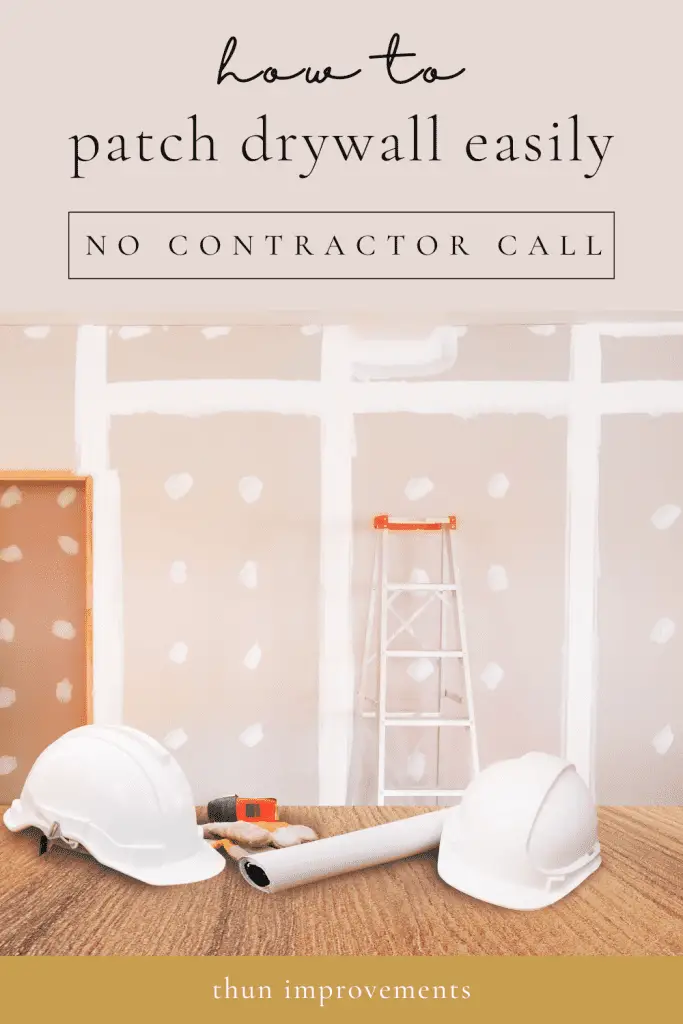Easily Patch Your Drywall Holes With These Steps
Drywall is a popular building material used in most modern homes. Accidents happen, and sometimes we end up with holes in our walls. These holes, whether small or large, can be an eyesore and can reduce the value of your house. In this blog post, we will discuss how to patch drywall holes and restore your walls to their original beauty.
This post may contain affiliate links. For my full disclosure please see my privacy policy.
Use The Right Tools
To patch drywall holes, you will need a few essential tools, including:
| 1. Putty knife | 2. Sandpaper (fine-grit) |
| 3. Spackle or joint compound | 4. Paintbrush |
| 5. Primer | 6. Paint |
Prepping Your Drwall
Before you begin to patch the drywall, you will need to prepare the area around the hole. First, remove any loose drywall or debris around the hole.
Next, use a putty knife to spread spackle or joint compound over the hole, making sure to fill in the hole completely. Once the hole is filled, allow the spackle or joint compound to dry for at least 24 hours.
Sanding and Painting the Patched Area
After the spackle or joint compound has dried completely, you will need to sand the patched area until it is smooth and level with the surrounding wall.
Use a fine-grit sandpaper to gently sand the area until it is smooth to the touch. Once the area is sanded, wipe away any dust using a damp cloth.
Finally, you will need to paint the patched area to match the surrounding wall. Start by applying a coat of primer to the patched area and allow it to dry completely.
Once the primer is dry, apply a coat of paint that matches the surrounding wall. If needed, apply a second coat of paint to ensure the patched area blends in seamlessly with the rest of the wall.
Using A Drywall Patch Kit

Using a drywall patch kit, will make it even easier to close off and repair a hole in your wall.
You would get your material out, add the mesh to the hole and then cover with the joint compound (spackle) and wait for it to dry.
Once it is dry – you would sand it down and paint.
When to Call a Professional
While patching drywall holes is a simple process, some holes may require the help of a professional. If the hole is larger than 6 inches in diameter, it may be best to call a professional to ensure the patch is done correctly. Additionally, if there is any damage to the framing or structure behind the drywall, a professional should be called to inspect and repair the damage.
Tips and Tricks for Patching Drywall Holes
Patching drywall holes can be a daunting task, but with the right tools and techniques, it can be an easy and rewarding experience. Here are some additional tips and tricks to help you patch drywall holes with ease:
Don’t Rush the Drying Process
One of the most common mistakes people make when patching drywall holes is not allowing enough time for the spackle or joint compound to dry. It’s crucial to wait at least 24 hours before sanding or painting the patched area. Rushing the drying process can result in a lumpy or uneven surface that will be difficult to sand and paint.
Sand Gently
When sanding the patched area, it’s essential to be gentle and take your time. Sanding too aggressively can damage the surrounding drywall, creating more work for you in the long run. Use a fine-grit sandpaper and sand in a circular motion, applying light pressure.
Painters Tape
If you’re worried about getting paint on the surrounding wall, use painters tape to create a border around the patched area. This will help keep the paint contained and ensure a clean finish.
Practicing
Patching drywall holes can take some practice to get right. If you’re new to the process, start with a small hole and work your way up to larger ones. Don’t be afraid to make mistakes; they can be easily fixed with a little extra spackle or joint compound.
Conclusion
Patching drywall holes can seem like a daunting task, but with the right tools and techniques, it can be a simple and rewarding experience. Remember to take your time, allow enough drying time, and use gentle sanding techniques to achieve a professional-looking finish. And if you’re ever unsure about the size or severity of the hole, don’t hesitate to call a professional for help. Happy patching!

How to patch small drywall holes
You may also like:
Your First Tool: How to use a drill gun for beginners
How to use a circular saw (for home DIY)

